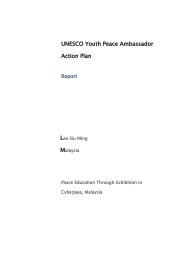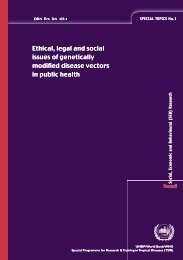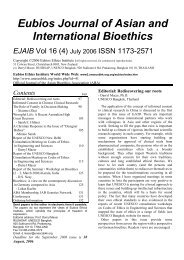Human Dignity, Justice, Fairness, Youth - Eubios Ethics Institute
Human Dignity, Justice, Fairness, Youth - Eubios Ethics Institute
Human Dignity, Justice, Fairness, Youth - Eubios Ethics Institute
You also want an ePaper? Increase the reach of your titles
YUMPU automatically turns print PDFs into web optimized ePapers that Google loves.
46 <br />
Macer, DRJ and Saad-Zoy, S. eds., Asia-Arab Interregional Philosophical Dialogues:<br />
<strong>Human</strong> <strong>Dignity</strong>, <strong>Justice</strong>, <strong>Fairness</strong>, <strong>Youth</strong>, Democracy and Public Policy (UNESCO, 2011)<br />
vedic traditions), Greeks (180 BC-10 AD, north-west Indian subcontinent, bringing with it a<br />
confluence of Buddhism, Zoroastrianism, Hinduism, ancient Greek religion and a vast<br />
incorporation of various customs into Indian lifestyles), Scythians, Parthians, Kushans (2 nd<br />
century BC-4 th century AD, Indo-European tribes with more or less same lifestyle who were<br />
influenced by Buddhism in Gandhara), Sassanids (Persian culture), the Huns and later the<br />
Arabs. 2 Arabs in 5 th century AD, conquering Persia, moved eastward to Afghanistan spreading<br />
Islam which was a totally different religion to this part of Indian subcontinent. During the eighth<br />
through the ninth centuries, many inhabitants of what is present-day Afghanistan and<br />
western Pakistan were converted to Sunni Islam. Islam as a part of people’s lives came into<br />
being around 870 AD in Kabul, around 11 th century in and around the whole of present day<br />
Afghanistan and Pakistan and by 1206 AD Delhi Sultanate (of Turkic origins) established the<br />
first Indo-Muslim kingdom which lasted till 1526 AD when it was absorbed by the emerging<br />
Mughal empire.<br />
Late Medieval & Early Modern India (c. 900 AD- 1600 AD)<br />
Islam has been a prominent religion and a way of life in the Indian subcontinent since around 9 th<br />
century. When the Muslim rulers invaded India, they brought with them all their customs and<br />
laws. Sharia law is the moral code and religious law of Islam. Sharia was derived from two<br />
sources of Islamic law: teachings of Quran and the example set by the Islamic prophet<br />
Muhammad in the Sunnah. The current Islam in India is different in terms of its customs than its<br />
counterpart in the middle-east because from this invasion in 11 th century it has assimilated into<br />
and has learned to live with the previous peoples of the region. Fiqh was the jurisprudence that<br />
interprets and extends the application of sharia to questions not directly addressed. It dictates<br />
human behavior based on five types of actions: obligatory (fard), recommended (musthabb),<br />
neutral (mubah), discouraged (makruh) and forbidden (haraam). These usually include the<br />
consensus of the religious scholars (ijma) and analogy from the Quran and<br />
Sunni (qiyas). Shia jurists prefer to apply reasoning (aql) rather than analogy in order to address<br />
difficult questions. Thus, concept of justice has been a vague term since the Delhi Sultanate and<br />
through the Mughal Empire in the laws of Islam. 3<br />
A concept of ‘Circle of <strong>Justice</strong>’ has been an integral part of most of the justice systems for<br />
Islam throughout history which can be seen from the following verse:<br />
There can be no government without men,<br />
No men without money,<br />
No money without cultivation,<br />
And no cultivation without justice and good administration 4<br />
<strong>Justice</strong> here, in a social sense, points to much more than equality. It shows the relation between<br />
the progress of a society and the protection, stable administration, an active responsive<br />
infrastructure provided by the government. A just king had to follow this vague notion of<br />
‘justice’ for the farmers, who in turn provided taxes to the treasury, in order that government<br />
workers might be paid to protect the kingdom, bring order into society, enforce decisions and<br />
refrain from exploiting their subjects. Just like the monarchy previously present in the Indian<br />
subcontinent, idea behind supporting a hierarchical social system was to actually show the<br />
interdependency of the classes and yet emphasize the need for cooperation between the classes.<br />
This idea of justice acknowledged inequalities of power but sought to mitigate their worst<br />
effects.

















